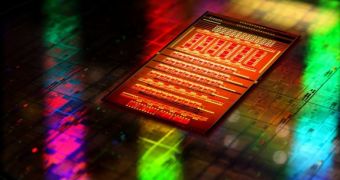Chip developers are always looking for ways that might help them create a processor that is faster and more power-efficient, and it appears that IBM just reached a milestone in its efforts to combine electrical and optical signals.
What IBM did was build a piece of silicon that can hold both optical and electrical components, so that it may communicate using light pulses, for a much faster data exchange between chips.
The 2-in-1 technology sued to achieve this is known as CMOS Integrated Silicon Nanophotonics and actually brings closer the days of Exaflop supercomputers.
For those that do not know, an Exaflop is the equivalent of one million trillion calculations.
The achievement is owed to the existence of integrated ultra-compact active and passive silicon nanophotonics devices, which are scaled down to the diffraction limit.
The diffraction limit is the smallest size that dielectric optics can reach without becoming useless.
IBM is also glad to say that the ability to transmit data via light was achieved without having to add any new tools to a standard CMOS manufacturing line.
"Our CMOS Integrated Nanophotonics breakthrough promises unprecedented increases in silicon chip function and performance via ubiquitous low-power optical communications between racks, modules, chips or even within a single chip itself," said Dr. Yurii A. Vlasov, Manager of the Silicon Nanophotonics Department at IBM Research.
"The next step in this advancement is to establishing manufacturability of this process in a commercial foundry using IBM deeply scaled CMOS processes," Vlasov added.
"The development of the Silicon Nanophotonics technology brings the vision of on-chip optical interconnections much closer to reality," said Dr. T.C. Chen, vice president, Science and Technology, IBM Research.
"With optical communications embedded into the processor chips, the prospect of building power-efficient computer systems with performance at the Exaflop level is one step closer to reality," Chen concluded.

 14 DAY TRIAL //
14 DAY TRIAL //